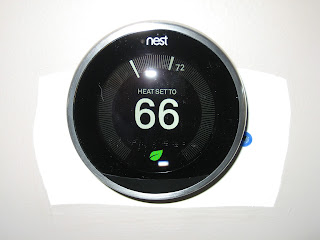I'd read about the Nest thermostat before. In fact, back when the Young House Love blog existed and I was an avid reader, John installed one in their house. So I was not uninterested in this new arrival. I opened it up and was immediately taken in by the beautiful packaging. I have to say, I'm a sucker for good packaging. I hate it when things come in giant packages with tons of wasted space. This was compact and layered quite wonderfully.
First layer
Lift out the first layer, and you reveal the second layer
Lift out the second layer, and you get to the third layer
Lift out the third layer, and you have the fourth and final layer of goodies!
I read the instructions to have an overview of what I'd need to be doing, then got started. The first thing to do was turn off everything. We have dual zones, and although I was only replacing the thermostat for one zone, I turned off the breakers for both zones, just to be safe.
The next step is taking off the thermostat cover.
The wiring inside ours was very simple. Like John, I was a big fan of the included stickers for labeling the wires to help remember which is which. Some of them were a little tough to free from their restraints, but I eventually got all out and labeled. Then it was just a matter of unscrewing the rest of the plate from the wall and swapping to the new one.
Again, HUGE fan of the built-in level. After screwing on the back-plate, snapping on the thermostat was, well, a snap!
The software started right up and walked through the language and location setup. I wasn't able to test the air conditioning because Nest was on the Internet and said that outdoor temperatures in my area were too cold; Nest won't turn on air conditioning if outside temperatures are below a certain point (I think it was 50 deg F, but I don't remember for sure. It might have been 60. The picture above was taken at a different time). But I was able to successfully test the heat and fan, so I felt some warm-fuzzies that I had done the wiring correctly.
As you can see from the above photo, the Nest is much smaller than our previous thermostat, revealing an area of unpainted wall and some drywall anchors. I debated what to do about this. That fourth layer of packaging contained a wall plate for just such a circumstance; however, it was a sort of creme color. This would have perfectly matched the wall before I painted it tan, but I didn't think it would look good not matching the wall and not matching the sleek black and chrome Nest. I thought about removing the drywall anchors and patching and painting the wall. I found a paint can in the garage of the paint used for these walls, but it turned out to be empty (I subsequently threw it out). I could have gotten some more, but I didn't want to get a whole gallon for a tiny patch job and didn't know if I could get a small amount that would still match well enough. So in the end, I grabbed some black spray paint I had lying around and spray painted the creme wall plate. I'm still not sure how I feel about it, but it's good enough for now.
I think we're still kind of in the learning phase, both for the Nest and for me. We're in a time of year when we often just have both heat and air conditioning off, so that's happening a lot, so I'm not sure how much learning is happening then. As we get more into colder times, I guess we'll see how it goes.










No comments:
Post a Comment